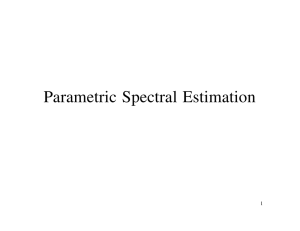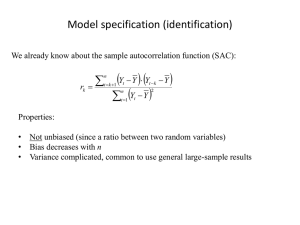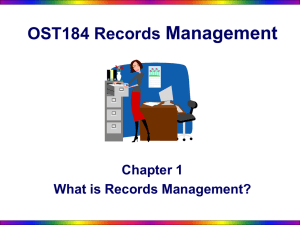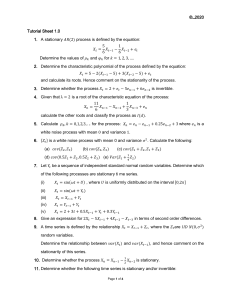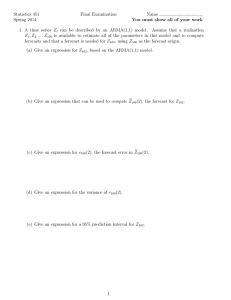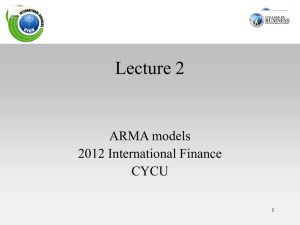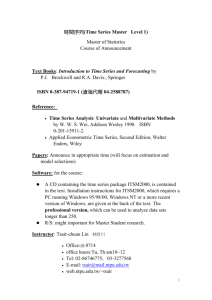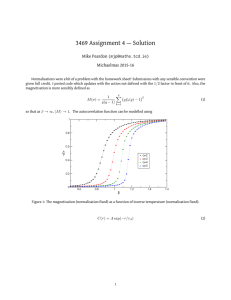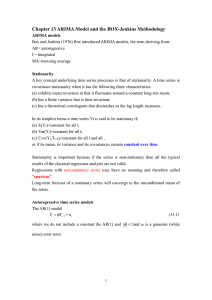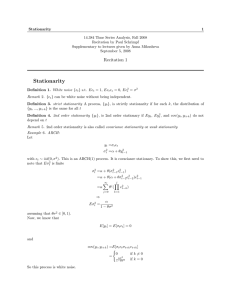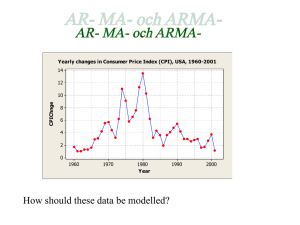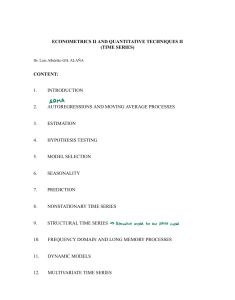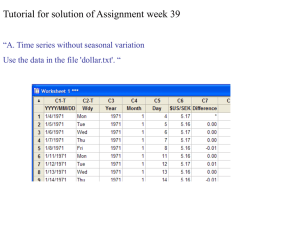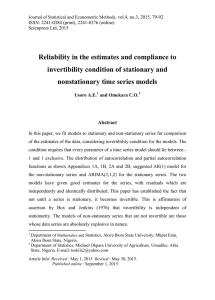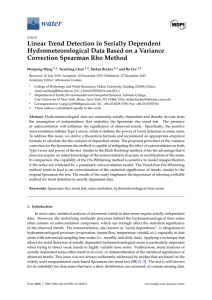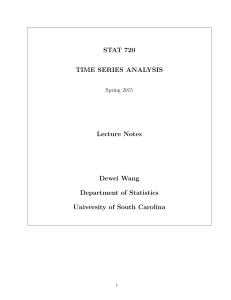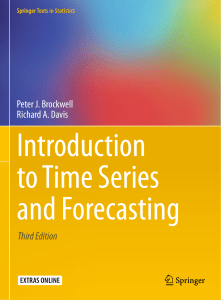Stat 551 Exam 1 October 25, 2012 Signature
advertisement
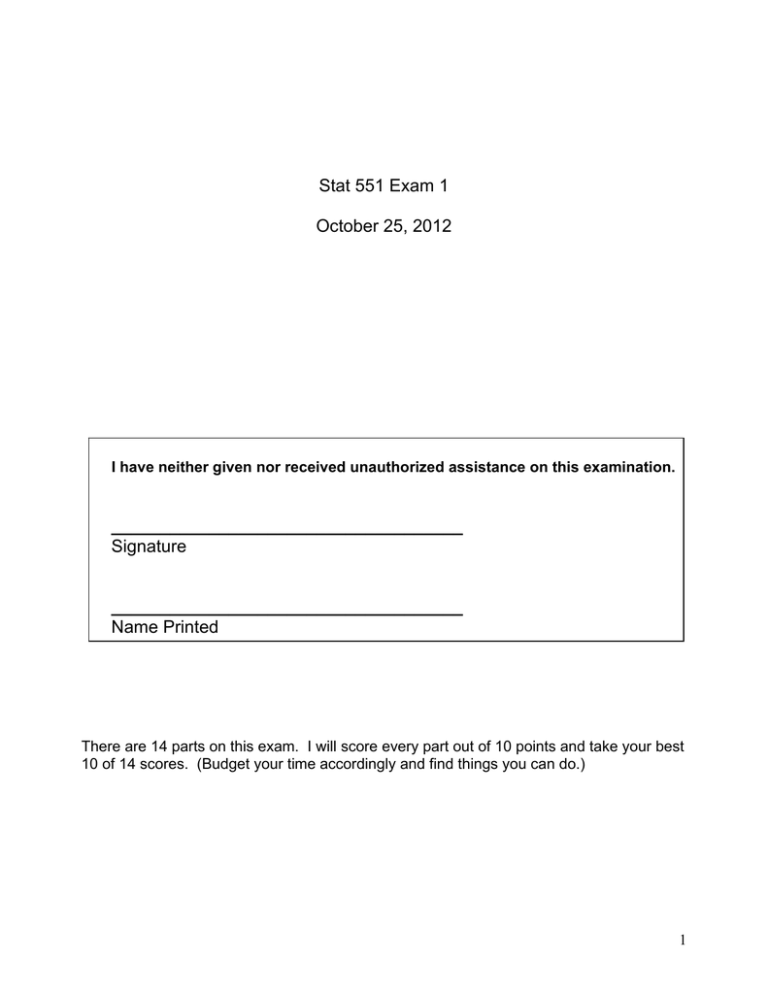
Stat 551 Exam 1
October 25, 2012
I have neither given nor received unauthorized assistance on this examination.
____________________________________
Signature
____________________________________
Name Printed
There are 14 parts on this exam. I will score every part out of 10 points and take your best
10 of 14 scores. (Budget your time accordingly and find things you can do.)
1
1. Two independent mean 0 second order stationary time series {ut } and {vt } have respective
autocovariance functions γ 1 ( s ) = σ 12 ρ1 ( s ) and γ 2 ( s ) = σ 22 ρ 2 ( s ) .
a) Is the series {wt } defined by wt = ut vt second order stationary? If so, what is its autocorrelation
function?
b) For constants a and b , is the series {wt } defined by wt = aut + bvt second order stationary? If
so, what is its autocorrelation function?
2
2. Suppose that the time series { yt } is second order stationary with mean 0 , variance 1 , and has
the autocorrelation function ρ ( s ) = exp ( − s ) .
a) Write out the covariance matrix for Y4 = ( y1 , y2 , y3 , y4 )′ (call it Σ 4 ) and give a matrix
expression for the covariance matrix of DY4 = ( y2 − y1 , y3 − y2 , y4 − y3 ) . (You do not need to
simplify this latter, but all relevant numerical values need to be plugged in.)
b) Give a matrix expression for a 95% prediction interval for y6 based on Y4 (defined in part a)).
Except for Y4 and Σ 4 (for which you may use these symbols) all other matrices and vectors need to
have numbers plugged, but you need NOT simplify/do matrix computations.
3
3. The function ρ c ( s ) = exp ( −c s ) is a valid autocorrelation function for any c > 0 . Suppose that
the time series { yt } is second order stationary with mean 0 and variance σ 2 , but neither c nor σ 2
is known. Data available are Y4 = ( y1 , y2 , y3 , y4 )′ . Write out a function of c and σ 2 (say L ( c, σ 2 ) )
that might plausibly be maximized in order to produce good estimates of these two model
parameters. You should use matrix notation.
4. Write in both operator notation and in difference equation notation (involving series values like
yt ) the form of a model for Y where a mean 0 SARIMA (1,1,1) × ( 0,1, 0 )4 noise process obscures a
transfer function mean based on a predictor series x involving a time delay of r = 4 , a "numerator
order" of m = 1 (a single lag), and "denominator order" of l = 0 (no lags).
4
5. Consider the simplest of all ARIMA models, one where DY is mean 0 variance σ 2 white
noise. (This, of course, gives a mean and covariance matrix for DYn .) Suppose that (in more or
less standard time series fashion) for forecasting purposes one assumes that y1 is uncorrelated with
DYn . In order to finish making a complete joint model for Yn one needs to make some assumption
about the marginal of y1 . We'll suppose that Ey1 = μ and Vary1 = η 2 .
(
)
a) What are the mean vector and covariance matrix of y1 , (DYn )′ , yn +1 under the above
n +1
assumptions? (Note that yn +1 = y1 + ( yt − yt −1 ) . Writing the covariance matrix in partitioned
t =2
form where the upper left block is n × n should make this quickly doable.)
(
b) Under these assumptions, what is the best linear predictor of yn +1 given y1 , (DYn )′
equivalently Yn )? (Write this in matrix form and simplify.)
) (or
5
6. Consider the ARMA form Φ (B ) Y = Θε for ε mean 0 white noise, where
Φ (B ) = I − .25B 2 and Θ (B ) = I − .5B
This apparent ARMA ( 2,1) form is not the simplest possible ARMA form for such a Y . Indeed
the standard argument employed to show an ARMA model is both causal and invertible cannot be
applied to the present representation. However, there is another representation that can be used.
a) Argue very carefully that there is another representation Φ* (B ) Y = Θ*ε that reveals that Y
satisfying the original equation is actually a causal and invertible ARMA process of lower order
than ( 2,1) . (You will want to expand Φ (B ) as the "product" of two "backshift monomial"
operators.)
b) In light of a), what are
• the autocorrelation function,
• the partial autocorrelation function, and
• the inverse autocorrelation function
for the process Y ?
6
7. Consider the mean 0 ARMA (1, 2 ) series { yt } satisfying the difference equation
yt − .5 yt −1 = .1ε t − 2 − .2ε t −1 + ε t
a) Find the first 4 coefficients ψ j (namely ψ 0 ,ψ 1 ,ψ 2 ,ψ 3 ) in the (" MA ( ∞ ) ") representation
∞
yt = ψ sε t − s .
s =0
b) Use your answer to a) and find the values of the lag 1 and 2 autocorrelations for this model,
ρ (1) and ρ ( 2 ) .
7
8. Below are pieces of more or less standard advice in applied time series analysis. Explain (in 100
words or less each) their origins. (Say why they are correct.)
a) When seasonality of period s is likely, one should try seasonal differencing at lag s before
resorting to applications of "ordinary" differencing.
b) If upon fitting an ARMA ( p, q ) model, the fitted pth order complex polynomial φ ( z ) has a
factor (1 − αˆ z ) where αˆ ≈ 1 (say φ ( z ) ≈ (1 − z ) φ * ( z ) for φ * ( z ) a ( p − 1) st order complex
polynomial with real coefficients), then the original series has not been adequately differenced.
8
